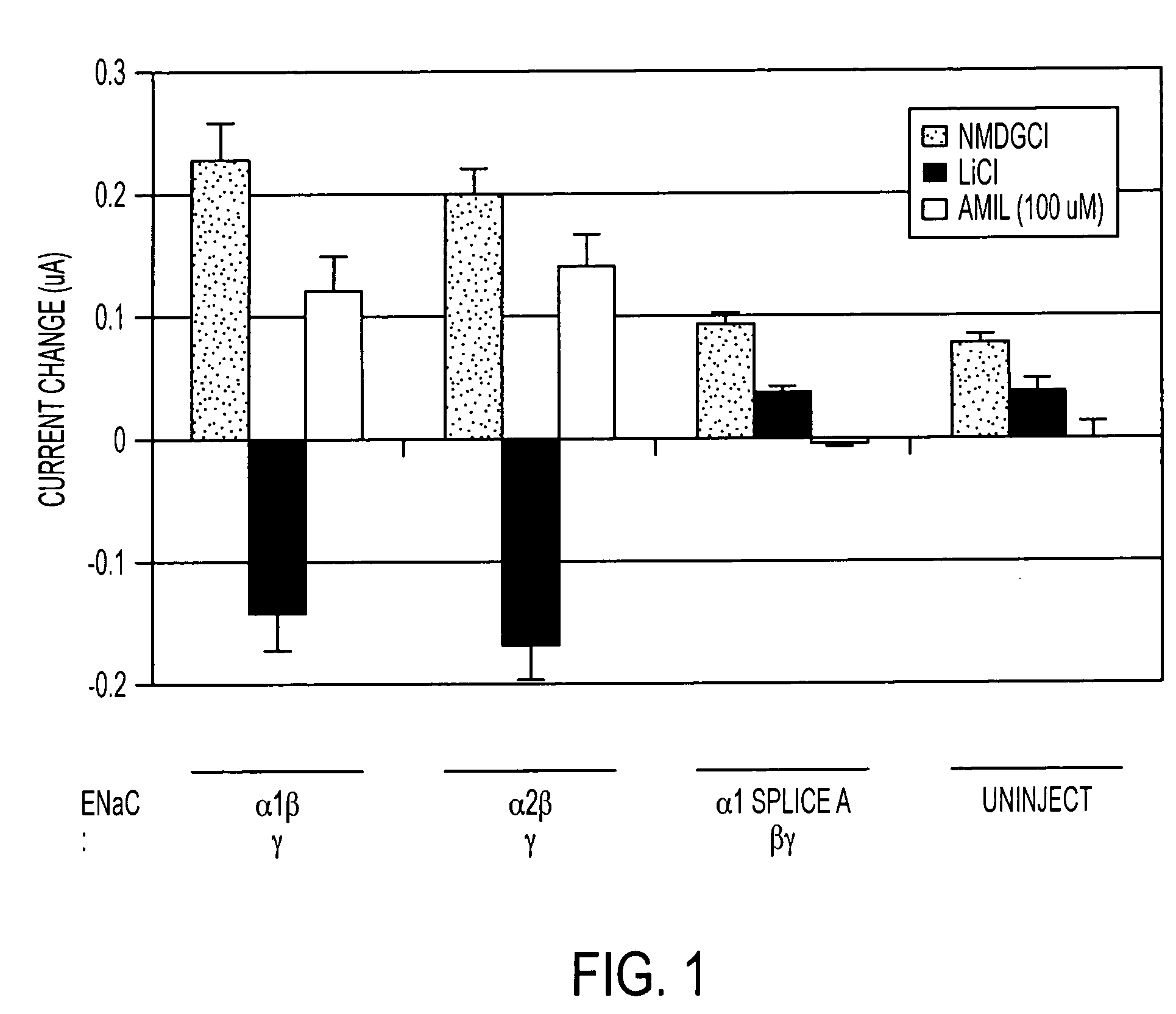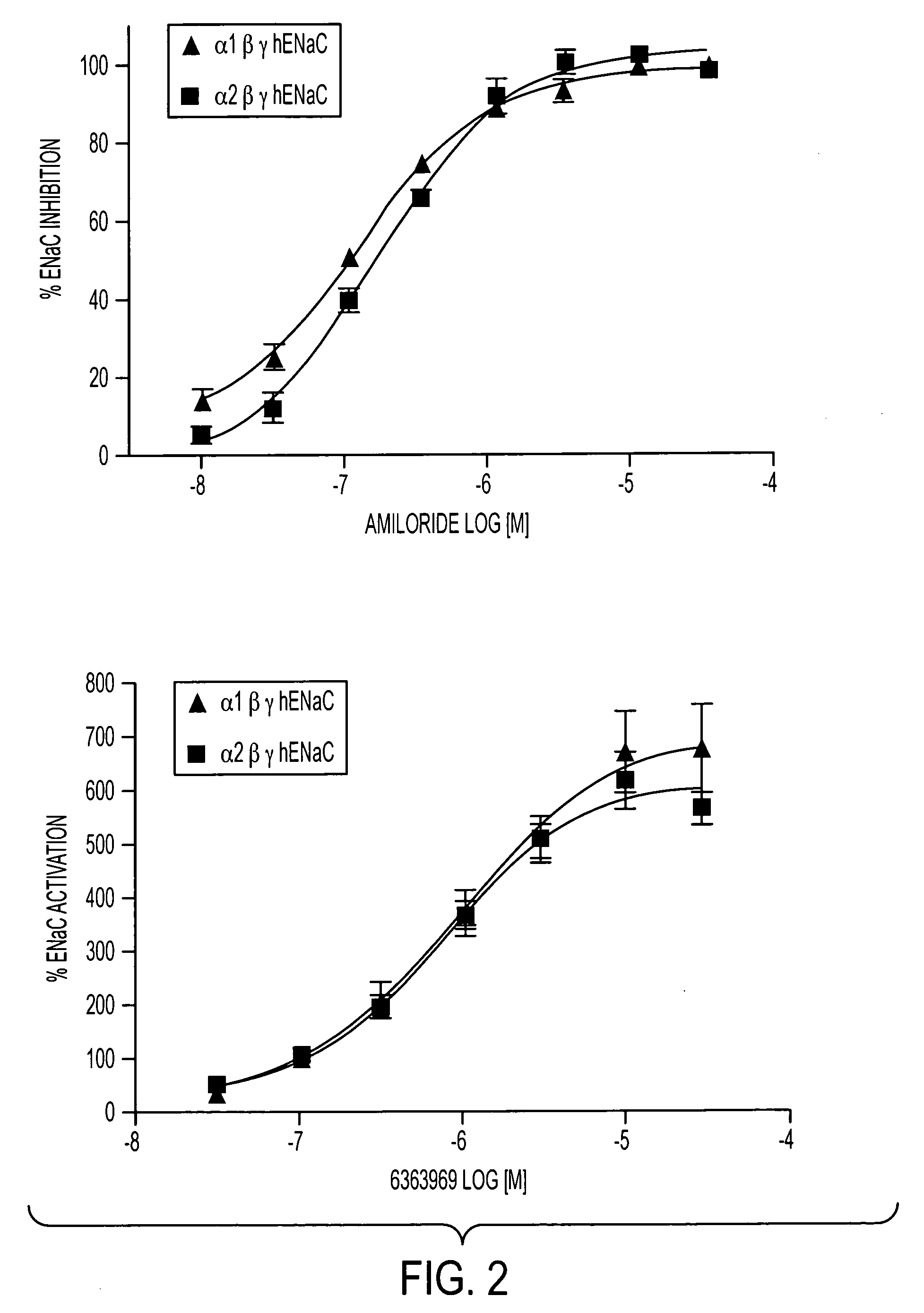Novel splice variants of human epithelial sodium channel genes expressed in human taste tissue and uses thereof
a technology of epithelial sodium channel and gene expression, applied in the field of new splice variants of human epithelial sodium channel genes expressed in human taste tissue, can solve the problem of not promoting salt intensity, and achieve the effect of promoting salt intensity
- Summary
- Abstract
- Description
- Claims
- Application Information
AI Technical Summary
Benefits of technology
Problems solved by technology
Method used
Image
Examples
example 1
Isolation and Sequencing of ENaC Splice Variants According to the Invention
[0052] Human circumvallate taste papillae on tongues were obtained from 2 independent post-mortem donors through a contract with Dr. Mark Whitehead and UCSD (contacts WHIM01-11 and CALU11-11). Total RNA was purified using the TOTALLY RNA purification kit (Ambion) and cDNA was synthesized using SuperScriptIII (Invitrogen) following the manufacturer's instructions. RT-PCR analysis confirmed expression of taste-specific genes including T1R1, T1R3, gustducin, PLB-β2, and TRPM5, demonstrating that obtained tissue actually contained taste buds. Primers spanning the full-length open reading frames for α1, α2, β, and γ ENaC were used to amplify ENaC channel subunit mRNAs. PCR products were cloned into the pGEM-T Easy vector (Promega) following the manufacturer's instructions. Between 50 and 150 total clones were analyzed (number of clones is total from both donors) by DNA sequencing to compare taste ENaC mRNA sequen...
example 2
Functional Expression of ENaC Comprising Splice Variant According to the Invention
[0058] Experiments are conducted to identify a human taste tissue expressed ENaC splice variant according to the invention which when expressed in association with other splice variants according to the invention and / or other ENaC subunit sequences (e.g., Kidney-derived ENaC subunit sequences disclosed in U.S. Ser. No. 133,573 incorporated by reference in its entirety herein) yields a functional ENaC.
[0059] In these experiments, functionality is determined based on the following properties:
[0060] 1) basal sodium channel activity;
[0061] 2) weak or no inhibitory effect of amiloride on basal sodium channel currents; and
[0062] 3) weak or no stimulating effect on kidney ENaC enhancers on channel currents.
[0063] An ENaC channel exhibiting such properties will confirm our hypothesis concerning the reason for the lack of a detectable effect of amiloride kidney ENaC enhancers in human taste tests (using k...
example 3
Effect of Kindey ENaC Enhancers on Channel Activity
[0074] Using oocytes which express the ENaC subunit combinations described in the previous example, the effect of various kidney ENaC enhancers was tested on channel activity. These experiments used proprietary compounds previously shown by the present Assignee to enhance kidney ENaC channel function:
[0075] 1) 3912721 (A proprietary compound produced by Pictet-Spenglar Chemistry that enhances kidney ENaC);
[0076] 2) 8246776 (A proprietary sulfonylurea chemistry compound that enhances kidney ENaC); and
[0077] 3) 6363969 (A proprietary thio-indole chemistry compound that enhances kidney ENaC).
[0078] The results of these experiments are contained in Table 1:
α1 SpliceCompoundα1βγα2βγA βγUninject.3912721 93 + / − 27% 99 + / − 32%InactiveInactive(50 uM)Pictet Spengler8246776299 + / − 65%291 + / − 47%InactiveInactive(50 uM)Sulfonylurea63639691294 + / − 238%1033 + / − 153%InactiveInactive(10 uM)Thio-indole
[0079] The results summarized in the Table...
PUM
| Property | Measurement | Unit |
|---|---|---|
| Cell angle | aaaaa | aaaaa |
| Nucleic acid sequence | aaaaa | aaaaa |
| Fluorescence | aaaaa | aaaaa |
Abstract
Description
Claims
Application Information
 Login to View More
Login to View More - R&D
- Intellectual Property
- Life Sciences
- Materials
- Tech Scout
- Unparalleled Data Quality
- Higher Quality Content
- 60% Fewer Hallucinations
Browse by: Latest US Patents, China's latest patents, Technical Efficacy Thesaurus, Application Domain, Technology Topic, Popular Technical Reports.
© 2025 PatSnap. All rights reserved.Legal|Privacy policy|Modern Slavery Act Transparency Statement|Sitemap|About US| Contact US: help@patsnap.com


